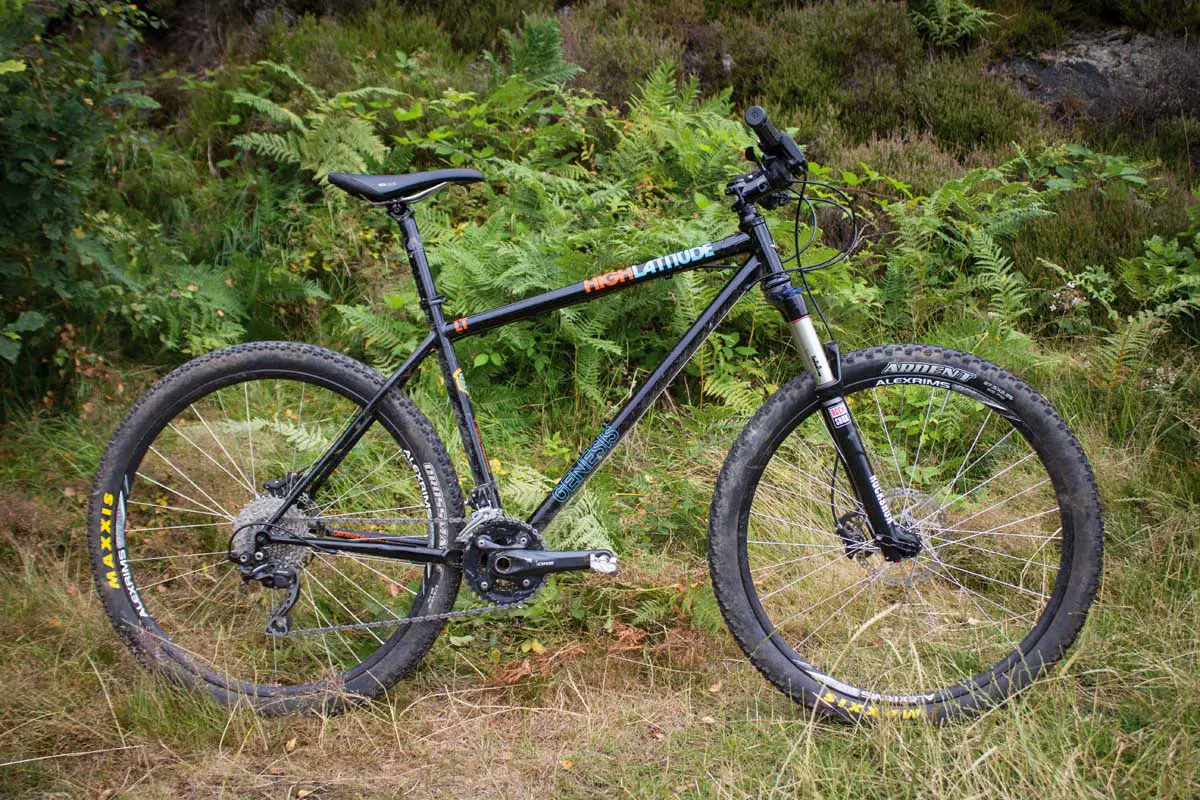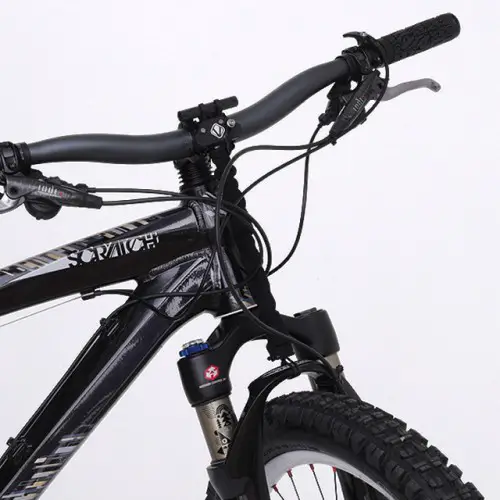Genesis’ High Latitude LT (long travel, natch) is a variant of its popular 29in bike, the High Latitude, but with 27.5in wheels and, er, longer travel.
It’s designed to be a bouncier, more puppyish bike compared to its substantially-hooped stablemate, and as such there are a few key differences apart from the obvious one to do with wheel size.
The bike comes armed with a RockShox Reba 120mm fork to help those slightly smaller wheels bounce over roots and rocks, and it’s made from Reynolds 631, “for a lively, forgiving ride”, instead of the standard High Latitude’s Reynolds 520. There are some really nice touches – like the Reynolds DZB externally-butted seat tube that tapers from 34.9mm (to hold a front mech) at the bottom to 34.1mm at the top. This allows you to use a 31.6mm dropper post – something you can’t always do with a steel-tubed bike. (Genesis was the first company to ask Reynolds to make this tube, fact fans.) All these touches conspire with the graphics to make a rather good-looking machine. The angles are fairly neutral – with 27.5in wheels the 69.2//DEG// head angle is neither breakneck twitchy nor too laid back, and should serve to sharpen up the steering should you want to work the front, or keep it relaxed if you want to enjoy the view.
The High Latitude LT is festooned with Shimano. There’s a full Deore groupset to help it go, and the brakes have respectably sized 180/160mm front and rear rotors to make it stop. This proved ample, even for our heftier testers (ahem). Deore hubs laced to Alex rims make for strong, if somewhat substantial wheels, which are wrapped with Maxxis tyres front and rear – the combination of Crossmark and Ardent is a popular and effective choice across much of the UK. Handily, the rims are tubeless-ready if you fancy experimenting with smelly white chemicals and the like.
Finishing kit is all robust, quality stuff: an 80mm stem on our test bike (although the website says the 19in bike should come with a 70mm) is bolted to a nice, wide 740mm bar for extra stability and confidence. An own-brand Madison saddle tops the seatpost, which is – well, a seatpost. For the sort of riding this bike is aimed at, upgrading this to a dropper post would be an excellent first move. Indeed, this may well be expected, as a quick-release seatpost clamp is not included.
Trail notes.
Upon first legover, the bike was a bit of a handful. The fork felt a little spiky, and the bike fought my line choices.
I let a little air out of the fork, tweaked the rebound damping and let some air out of the tyres too; the bike immediately felt much more alive. The front end was nice and light, but I could easily get over the front to muscle it round corners. Singletrack was despatched with ease – this bike loves to carve turns, and feels wonderfully stiff and stable when mashing out of the saddle. If you’re on smooth, pumpy trails, and you’ve got the energy to really throw the bike around, it’s brilliant, and really rewards the effort you put in.
It did feel somewhat direct when things turned towards the extra-steep, rocky or slabby end of things (an inevitable symptom of testing in Calderdale), but it’s quite possible that this could be remedied to a certain extent by different tyre choice. I can see this bike excelling for woodsy singletrack, high speed trail-centre blats, or long distance all-day rides. As it stands, for shorter messing-about-in-the-woods rides, the lack of a quick-release seatpost clamp (or dropper post) is slightly annoying – any descent which is improved by a lower saddle needs some multitool fiddling – but this would be easily remedied by the addition of a £15 clamp. And in any case, if you plump for a dropper post the issue is moot.
Apart from this hiccup, the bike is specced very thoughtfully. The Deore groupset performed flawlessly – really, there’s little need to run anything else from a function point of view – and the fork, once I’d fiddled with the settings a little more, performed its duties with aplomb. All the other kit was fine, and the tyres are a good compromise. They might not work everywhere, all the time, but they work in most places, most of the time. The bike doesn’t ride particularly light, but neither does it ride heavy – it’s very balanced and neutral. I appreciated the control the wide bars gave, and they can easily be cut down if 740mm is too wide for you. Overall, the High Latitude LT is a fine trail machine, well suited to woodsy singletrack and ripping the turns.
Overall:
The Genesis High Latitude LT, apart from needing a catchier name, has everything a bike needs to be a great, ready-made trail machine – but it does feel a little ‘ordinary’ when compared to the other two bikes on test. That’s no bad thing: a plain vanilla ride is sometimes just what’s needed, but it’s neither as idiosyncratic as the Swift nor as sharp as the Soul. It’s still fun to ride though and if you’re on a tighter budget, then it’s worth a look. With some dedicated fork tweaking and a lighter wheelset, it has the potential to be a real singletrack delight.
- Frame // Genesis High Latitude LT, Reynolds 631 steel
- Fork // Rockshox Reba 120mm
- Hubs // Shimano Deore
- Rims // Alexrims Volar 2.6
- Tyres // Maxxis Ardent (front), Crossmax (rear)
- Chainset // Shimano Deore
- Front Mech // Shimano Deore
- Rear Mech // Shimano Deore
- Shifters // Shimano Deore
- Brakes // Shimano BR-M447 180/160mm rotors
- Stem // Genesis 0.2 MTB 70mm
- Bars // Genesis 0.2 MTB 740mm
- Grips // M:Part Vice grips lock-on
- Seatpost // Genesis 0.3 MTB 31.6 400mm
- Saddle // Madison Flux
- Size Tested // 19in
- Sizes Available // 16in, 17.5in, 19in, 20.5in
- Weight // 27.6lb without pedals
Review Info
| Brand: | Genesis |
| Product: | High Latitude LT |
| From: | Genesis, genesisbikes.co.uk |
| Price: | £1,499.00 |
| Tested: | by Barney. for |




